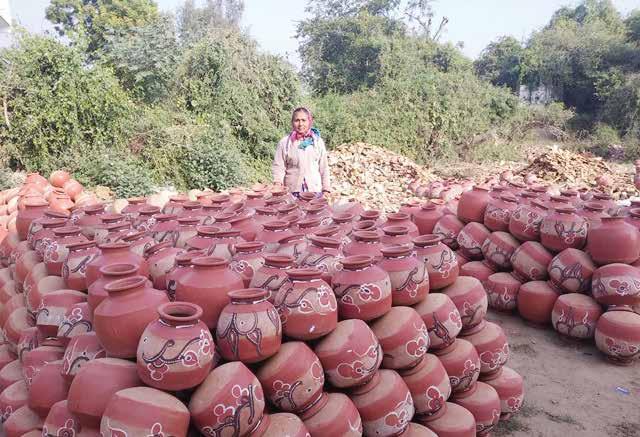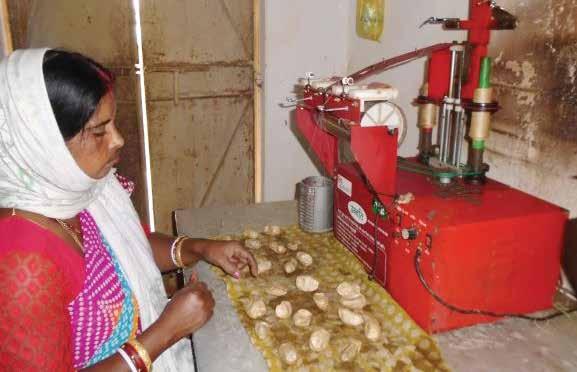
5 minute read
TABLE 10 : Artisans and their average productions
TABLE 10 :Artisans and their average productions Artisans category Approx. number of households Average volume of production per day (qtl) Average monthly production (qtl)
Small artisan (brass utensils) Medium artisan (brass and bronze utensils) Large artisan (brass utensils) 35
Advertisement
150
35
Total 220 0.6 to 0.70
0.75 to 1
1.5 and above 9–10
10–15
18 and above
Production process
The artisans use mostly two different alloys for making utensils, namely brass and bronze. Copper is the major raw material while zinc and tin are mixed in different proportions to make brass or bronze, respectively, depending on the type of utensils to be produced. The production process of brass and bronze utensils involves melting, casting, rolling, cutting, beating, etc., to provide the desired shape of the utensils. Thereafter, the products go through finishing processes, such as grinding, buffing, and polishing, after which they are ready for market delivery.
Energy consumption
Copper smelting and casting processes are highly energy intensive; hence, they can be economically viable and affordable only if conventional fuels and local technologies are used. Brick or clay-based furnace (bhatti) and sand or clay-based casting moulds are the local technologies adopted, hence, do not need much financial investment. Grinders and buff machines (scrapping and polishing) are used in finishing, which run on diesel generators, and thus provide scopes for solar intervention. While the large artisans have more machines that need more power, the home-based small and medium artisans have a few machines, thus require less motor power. The cleaning and finishing process of making brass products offers scope for introducing energyefficient technologies. The production units do not use grid electricity due to lack of reliability and affordability, hence are dependent on diesel generators. The cluster has immense potential to replace diesel generators with cleaner, reliable, and affordable energy systems, such as solar PV systems.
Design of solar PV
The present loads for small, medium, and large artisans are around 0.75 kW, 1.5kW, and 7.5kW, respectively. Keeping these factors in mind, solar PV systems were designed by considering operating hours and their schedule of operation of different brass artisan units along with the provision of additional power backup of at least 3 hours for rainy or cloudy days. The proposed solar PV capacities include 1.0 kWp, 2.0 kWp, and 5.0 kWp for small, medium, and large artisan units, respectively. The proposed system is a solar hybrid version for small and medium artisans and standalone for large artisans. While designing the solar system for all these three categories, the following assumptions or parameters were considered:
a. The existing hours of operation is 6 and 8 for medium and large artisans, respectively. b. The solar design for a medium artisan unit can meet the energy requirement of casting and finishing processes in alternate days with equal share of energy from grid electricity. Diesel can be replaced completely. Solar will address the quality issue.
c. The solar design for a large artisan unit can meet the entire energy requirements of finishing processes (energy for the casting process was excluded). Further, grinding and buffing (scrapping) are proposed to be operated in 1 day, while the buff polishing machines are proposed to be operated in the next or alternate day. Diesel is proposed to be replaced completely. Solar will also address the issue of non-availability of a commercial connection.
d. The existing hours of operation is 8 for the identified small artisan units, which includes 5 hours for blower operation in the casting and 3 hours for grinding machines in the finishing process. Both solar and grid electricity are proposed to meet energy requirement in the proportion of 80% and 20%, respectively. e. The estimated cost considered the benchmark cost for off-grid solar PV system circulated by MNRE amounts to INR 74 per watt and is applicable for 2019–20. This includes the entire cost of the systems, supply, installation, and 5-year annual maintenance as per the prescribed quality and system specifications.
Proposed business model
For this study, the brass cluster units were classified into small (1 kWp solar PV system), medium (2 kWp solar PV system), and large (5 kWp solar PV system) types based on estimated solar PV capacity that is likely required for powering these units. In small units, a model with 20% upfront investment and loan amounting to 80% of the hardware cost having interest of 12% per annum (3 years) would yield a payback period of 1.92 years. The payback period is estimated to be 1.82 years when the interest rate is reduced to 8% per annum. For medium units, a model with 20% upfront investment and 80% loan having interest rate of 12% (3 years) would yield a payback period of 1.58 years. The payback period is estimated to be 1.5 years when the interest rate is reduced to 8% per annum. For large units, a model with 20% upfront investment and 80% loan having interest rate of 12% (3 years) would yield a payback period of 2.79 years. The payback period is estimated to be 2.64 years when the interest rate is reduced to 8% per annum In this cluster, grants and subsidy can still be leveraged to reduce the risk of bank loan component, wherever it is required. KVIC, DIC, or KVIB can provide subsidy under PMEGP scheme (15–35%) to these micro-enterprises and the loan amount could be availed through MUDRA scheme from local financing institutions.
Solar potential assessment
The solar potential for this cluster was calculated based on the number of households engaged in different brassware production and the solar power pack designed for corresponding artisan units. An estimated aggregate solar PV potential21 of 500 kWp in the cluster is likely to be an attraction for investors and technology developers.
Solar potential assessment across the clusters in Jharkhand
The cumulative solar potential across all the studied clusters in the state was assessed and
21 Estimated based on 35 units of 1 kWp solar PV capacity systems, 150 units of 2 kWp solar PV capacity systems, and 35 units of 5 kWp solar PV capacity system




